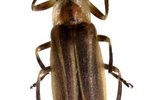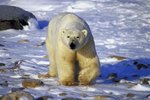
Although bears were once considered to not be true hibernators, it's been discovered that they are in fact "super-hibernators," able to alter their body systems to survive the sometimes harsh winters of their habitats. Bears go through five stages of activity and hibernation, including normal activity and hibernation, according to the North American Bear Center.
Normal Activity
Normal activity occurs during the spring and summer months. During this time, the bears gorge themselves on a great variety of nuts, berries and prey animals. Adult black bears eat between 5,000 and 8,000 kcalories per day in order to put on enough fat for their hibernation period. The period of normal activity is vital to many bears' survival during the winter.
Hyperphagia
Depending on where the bear lives, hyperphagia may begin as soon as midsummer or as late as autumn. While bears get fattened up during the summer, they do so to apparent extremes during the hyperphagia period. During this time, they eat more than three times the amount of calories they do in the summer. These calories turn into excess fat that will fuel the bears' bodies during hibernation. They also drink large amounts of water per day to help purge excess waste.
Transitional Period
The fall transition period is when the bears go through metabolic changes in preparation for hibernation. During this time, bears' heart rates drop by approximately half. Bears also greatly reduce their activity levels and sometimes sleep for 22 hours per day or more. Because metabolism slows, the bears eat much less during this time -- but they continue to drink large amounts of water to continue purging waste. Bears begin seeking out suitable dens for hibernation. The time of year this period takes place varies among species and locale, like all other stages of activity. The transitional period for bears in the Adirondacks is nearly over come mid-November; North Carolina black bears may go through this period anytime between November and January.
Hibernation
Hibernation can last as long as eight months for some northern bears where the winters are longer and harsher than other areas. During the hibernation stage, bears' heart rates will slow to between eight and 21 beats per minute. They don't eat, drink or relieve themselves during this time. Bears form fecal plugs -- made of intestinal cells, hair and bedding material -- during this time to help prevent defecation.
After Hibernation
As the bears emerge from their winter dens, they go through a period known as walking hibernation, in which their bodies start to adjust to being awake by slowly raising their metabolisms. They eat and drink less during this time than they will in the periods following, but they slowly start to eat more and drink more as this short stage continues. Bears emerge around mid-April in the Adirondacks; North Carolina bears emerge anytime between February and April.
References
- North American Bear Center: 5 Stages of Activity and Hibernation
- University of New York College of Environmental Science and Forestry: Adirondack Black Bears
- North Carolina Wildlife Resources Commission: What's in a Name? Hibernation Means Different Things to Different Animals
- National Park Service: Yellowstone National Park: Denning and Hibernation Behavior
Resources
Photo Credits
-
Jupiterimages/liquidlibrary/Getty Images
Writer Bio
With a professional background in gardening, landscapes, pests and natural ecosystems, Jasey Kelly has been sharing her knowledge through writing since 2009 and has served as an expert writer in these fields. Kelly's background also includes childcare, and animal rescue and care.




